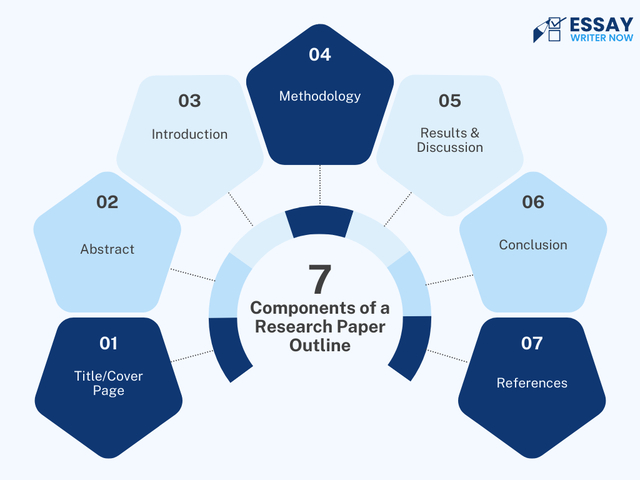What is a Research Paper Outline?
A research paper outline serves as a strategic tool that goes beyond a mere starting point for your writing—it's your blueprint for success. Imagine it as a roadmap that not only guides you through the writing process but also helps your readers navigate the complexities of your study.
By outlining your paper, you ensure that every section flows logically and coherently, building a strong foundation for your arguments and conclusions.
Components of a Research Paper Outline

- Title/Cover Page
The title or cover page is the first impression of your research paper. It includes essential details such as your name, your professor’s name, the course title, and the submission date. This page sets the stage for your paper and provides basic information about the study. - Abstract
The abstract is a concise summary of your entire research paper, typically around 250-300 words long. It highlights the main objectives, methods, findings, and conclusions of your study. A well-written abstract gives readers a quick overview of your research and its significance without needing to read the entire paper. - Introduction
The introduction serves as the gateway to your research paper. Here, you provide background information on your topic, explain why it's important or relevant, and clearly state your thesis or main argument or hypothesis. A strong introduction sets the tone for the rest of your paper and captures the reader's interest from the outset. - Methodology
The methodology section outlines the methods and procedures you used to conduct your research. It details how you gathered and analyzed your data, providing enough information for other researchers to replicate your study if they wish. Methodology ensures the credibility and reliability of your findings by showing how rigorously your research was conducted. - Results & Discussion
Results and discussion often go hand in hand in research papers. Here, you present your findings in a clear and organized manner, supported by evidence such as tables, graphs, or statistical analysis. After presenting your results, you discuss their implications and significance. This section is crucial for interpreting your findings and relating them to existing knowledge in the field. - Conclusion
The conclusion summarizes the key points of your research paper. It restates your thesis or main argument, reviews the main findings discussed in the results section, and emphasizes the broader implications of your study. Additionally, you may suggest avenues for future research or practical applications based on your findings. - References
References list all the sources cited in your paper, following MLA or APA format guidelines (depending on your discipline). Proper referencing is essential for academic integrity, acknowledging the work of others, and allowing readers to locate and verify the sources you used in your research.
Structure of a Research Paper Outline
Crafting an effective research paper outline involves choosing the right format that best suits your topic and writing style. Here are three popular formats, each offering a unique approach to organizing your thoughts and arguments:
Alphanumeric Research Paper Outline
The alphanumeric outline uses a combination of numbers and letters to organize sections and subsections hierarchically. This format is useful for organizing complex ideas and ensuring a clear structure.
Example:
| I. Introduction A. Background B. Thesis statement II. Body A. Main point 1 1. Supporting detail 2. Supporting detail B. Main point 2 III. Conclusion |
In this example, "I" and "II" represent main sections, while "A" and "B" denote subsections within each main point. Numbers (1., 2.) further break down the details under each subsection.
Full-Sentence Research Paper Outline
The full-sentence outline requires each point to be written as a complete sentence, providing a detailed preview of the content within each section. This format helps in clearly articulating ideas and their relationships.
Example:
| I. Introduction A. The background of the study provides context for understanding the research problem. B. The thesis statement clearly outlines the main argument of the paper. II. Body A. Main point 1 includes an in-depth analysis of the first aspect of the research topic. 1. Supporting detail explains the significance of the first aspect. 2. Additional evidence supports the main argument. B. Main point 2 examines another critical aspect related to the research topic. III. Conclusion summarizes the main findings and discusses their implications for future research. |
Here, each section and subsection is expressed as a complete sentence, offering a comprehensive overview of what each part of the paper will cover.
Decimal Research Paper Outline
The decimal outline uses a numerical system (e.g., 1.0, 1.1, 1.1.1) to show the hierarchy of information. This format provides a clear structure with levels of subordination indicated by decimals.
Example:
| 1.0 Introduction 1.1 Background 1.2 Thesis statement 2.0 Body 2.1 Main point 1 2.1.1 Supporting detail 2.1.2 Additional evidence 2.2 Main point 2 3.0 Conclusion |
In this outline, "1.0" and "2.0" represent main sections, while "1.1", "1.2", "2.1", and so forth indicate subsections with increasing specificity.
Research Paper Outline Formats
Here are outline templates for different research paper formats that you might be asked to write on:
MLA Format Research Paper Outline
Here is a sample outline you can use when writing a research paper in MLA format:
I. Introduction II. Body III. Conclusion IV. Works Cited (or References) |
APA Format Research Paper Outline
Here is a sample outline you can use when writing a research paper in APA format:
I. Title Page II. Abstract III. Introduction IV. Literature Review V. Methodology VI. Results VII. Discussion VIII. Conclusion IX. References |
ASA (American Sociological Association) Format Research Paper Outline
Here is a sample outline you can use when writing a research paper in ASA format:
I. Title Page II. Abstract III. Introduction IV. Literature Review V. Methodology VI. Results VII. Discussion VIII. Conclusion IX. References |
IEEE (Institute of Electrical and Electronics Engineers) Format Research Paper Outline
Here is a sample outline you can use when writing a research paper in IEEE format:
I. Title Page II. Abstract III. Introduction IV. Literature Review V. Methodology VI. Results VII. Discussion VIII. Conclusion IX. References |
Chicago Format Research Paper Outline
Here is a sample outline you can use when writing a research paper in Chicago style:
I. Title Page II. Abstract (if required) III. Introduction IV. Main Body V. Conclusion VI. Bibliography (or References) |
Harvard Format Research Paper Outline
Here is a sample outline you can use when writing a research paper in Harvard format:
I. Title Page II. Abstract (if required) III. Introduction IV. Literature Review V. Methodology VI. Results VII. Discussion VIII. Conclusion IX. References (or Bibliography) |
Goals of a Research Paper Outline
Crafting a well-structured research paper outline is not just a preparatory step; it is a strategic tool that offers numerous benefits throughout the writing process. Here’s a detailed exploration of why outlining is essential and the specific advantages it provides:
Clarity in Purpose
An outline serves as a roadmap for your research paper, defining its purpose and scope from the outset. By clearly outlining the objectives of your study, you ensure that every section and argument directly contributes to achieving those goals. This clarity helps both you, as the writer, and your readers to understand the focus and significance of your research.
Streamlined Organization
One of the primary functions of an outline is to organize your ideas in a logical sequence. It helps structure your thoughts into coherent sections and subsections, ensuring that each point flows smoothly into the next. This organization prevents your paper from becoming a disjointed collection of ideas and instead presents them in a cohesive narrative that is easy to follow.
Enhanced Focus and Efficiency
Writing a research paper can be a daunting task, often leading to scattered thinking and inefficient writing. An outline acts as a focal point, guiding your attention to the core arguments and supporting details of your study. By outlining the main points and their supporting evidence beforehand, you maintain focus on what is essential, thereby increasing productivity and reducing the likelihood of getting sidetracked.
Seamless Transitions
Effective transitions between sections are crucial for maintaining the flow of your paper and guiding your reader through your arguments. An outline allows you to plan these transitions strategically. By outlining how each section connects to the next, you ensure that your paper reads smoothly and that each point logically builds upon the previous one. This coherence enhances the overall readability and persuasiveness of your paper.
Time Management
Time management is a significant challenge in academic writing. An outline helps in effectively managing your time by breaking down the writing process into manageable tasks. By allocating specific sections to specific times, you can work systematically through your paper without feeling overwhelmed. This structured approach also allows for better scheduling of research, drafting, editing, and revision phases, ensuring that you meet your deadlines effectively.
Thesis Alignment
Central to any research paper is its thesis or main argument. An outline ensures that every section of your paper aligns with and supports this thesis effectively. By outlining the main points and evidence that will be discussed in each section, you maintain a clear focus on proving your thesis throughout the paper. This alignment strengthens the overall coherence and persuasiveness of your arguments, reinforcing the central message of your research.
Revision and Refinement
An outline facilitates iterative writing and revision processes. As you draft each section according to your outline, you can continuously assess its coherence and relevance to your thesis. This allows for ongoing refinement of your arguments, identification of gaps in logic or evidence, and adjustments to ensure that your paper maintains a high standard of academic rigor.
Research Paper Outline Samples
Here are some research paper examples that you can use as a reference to structure your paper
In conclusion, a well-crafted research paper outline acts as a strategic tool, guiding you through the writing process while ensuring your paper is organized and coherent. By following the outlined structure and formats, you can effectively transform your ideas into a compelling academic narrative.
Remember, a clear outline not only helps you write better but also enhances the clarity and impact of your research.










